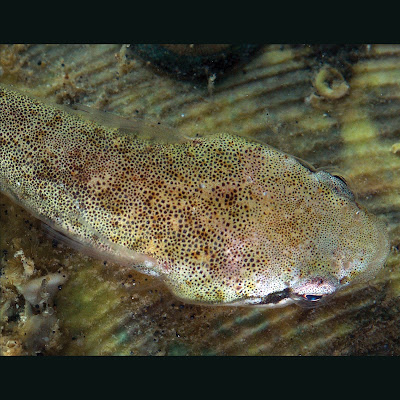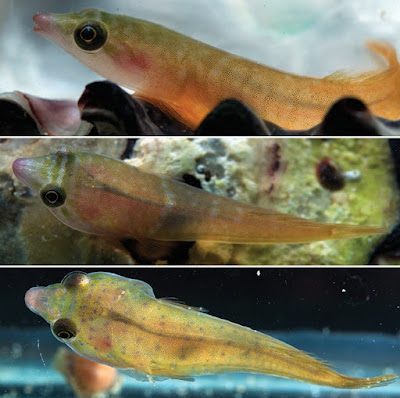 |
| Nettorhamphos radula Conway, Moore & Summers, 2017 |
Nettorhamphos radula, new genus and species, is described from two specimens, 20.3–40.2 mm SL, trawled from sponge and algae reefs between 30–40 meters in depth offshore from Fremantle, Western Australia. The new taxon is distinguished from all other members of the Gobiesocidae by having vast fields of tiny conical teeth throughout the oral jaws that are arranged in multiple, regular rows along the lingual surface of the premaxilla and the dentary. The new taxon is tentatively considered a close relative of two other southern Australian endemic clingfish taxa (Posidonichthys and the undescribed “Genus A”) based on the presence of a well-developed and heavily ossified subopercular bone that articulates strongly with both the opercle (dorsally) and the preopercle (anteriorly).
Nettorhamphos, new genus
Type species.— Nettorhamphos radula, new species
Etymology.— A combination of the Greek words (netta), meaning duck, and (rhamphos), meaning bill, curved-beak. Gender neuter.
Nettorhamphos radula, new species
Common name: Duckbilled Clingfish
Distribution and habitat.— Known to date only from two locations to the west of Five Fathom Bank (Indian Ocean), off the coast of Fremantle, Western Australia (Fig. 11). The new species was collected via trawls through algae/sponge reefs between 33–37 meters in depth. Other species of fishes collected by the same trawls include the pipefish Stigmatopora nigra, the labrids Austrolabrus maculatus, Eupetrichthys angustipes,Siphonognathus caninus, and S. attenuatus, and the gobiesocids Alabes occidentalis and ‘‘Genus A sp. 2’’ (sensu Hutchins, 2008).
Etymology.— From the Latin radula, a tool used for scraping. In reference to the many tiny conical teeth on the lingual surface of the premaxilla and dentary, which are reminiscent of the radula of a snail. A noun in apposition.
 |
| A full-body scan showing the underside of the fish. |
 |
| The only two known specimens were found on museum shelves, where they had sat for 40 years. photo: Kevin Conway and Glenn Moore |
Kevin W. Conway, Glenn I. Moore and Adam P. Summers. 2017. A New Genus and Species of Clingfish (Teleostei: Gobiesocidae) from Western Australia.
Copeia. 105(1); 128-140. DOI: 10.1643/CI-16-560
Copeia. 105(1); 128-140. DOI: 10.1643/CI-16-560
New many-toothed clingfish discovered with help of digital scans
---------------------------------------------------------------
روابط التحميل والمشاهدة، الروابط المباشرة للتحميل
او
شاهد هذا الفيديو القصير لطريقة التحميل البسيطة
كيف تحصل على مدونة جاهزة بآلاف المواضيع والمشاركات من هنا
شاهد قناة منتدى مدونات بلوجر جاهزة بألاف المواضيع والمشاركات على اليوتيوب لمزيد من الشرح من هنا
رابط مدونة منتدى مدونات بلوجر جاهزة بآلاف المواضيع والمشاركات في أي وقت حــــتى لو تم حذفها من هنا
شاهد صفحة منتدى مدونات بلوجر جاهزة بألاف المواضيع والمشاركات على الفيس بوك لمزيد من الشرح من هنا
شاهد صفحة منتدى مدونات بلوجر جاهزة بألاف المواضيع والمشاركات على الفيس بوك لمزيد من الشرح من هنا
تعرف على ترتيب مواضيع منتدى مدونات بلوجر جاهزة بآلاف المواضيع والمشاركات (حتى لا تختلط عليك الامور) من هنا
ملاحظة هامة: كل عمليات تنزيل، رفع، وتعديل المواضيع الجاهزة تتم بطريقة آلية، ونعتذر عن اي موضوع مخالف او مخل بالحياء مرفوع بالمدونات الجاهزة بآلاف المواضيع والمشاركات، ولكم ان تقوموا بحذف هذه المواضيع والمشاركات والطريقة بسيطة وسهلة. ــــــــــــــــــــــــــــــــــــــــــــــــــــــــــــــــــــــــــــــسلامـ.























